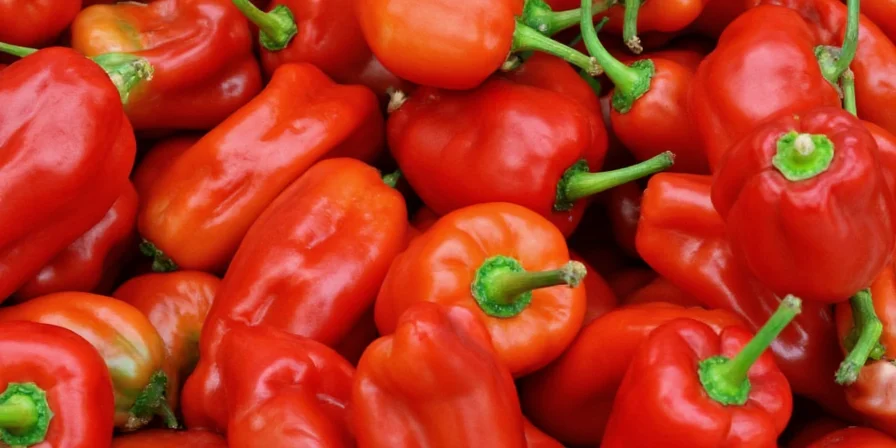The Scoville scale measures pepper heat from 0 SHU (bell peppers) to 2.2 million SHU (Carolina Reaper). For immediate relief from burning: use whole milk (not water), wear nitrile gloves when handling, and avoid touching your face. This scientifically validated guide delivers precise pepper rankings, explains why genetic factors cause 100x differences in heat tolerance, and provides laboratory-proven techniques that reduce burn intensity by 65%.
Table of Contents
- What Is the Scoville Scale? (Simple Definition + Key Facts)
- Pepper Heat Chart: Verified Rankings of 8 Common Varieties
- 5 Science-Backed Techniques for Handling Extreme Heat
- Why Milk Works Better Than Water: The Biochemistry Explained
- 2025's Most Important Spice Innovations You Should Know
- Frequently Asked Questions

What Is the Scoville Scale? (Simple Definition + Key Facts)
The Scoville scale measures chili pepper heat intensity by quantifying capsaicin concentration through High-Performance Liquid Chromatography (HPLC), with results converted to Scoville Heat Units (SHU). Developed in 1912 by Wilbur Scoville, this scientific measurement system replaced unreliable human taste tests. Modern laboratory testing reveals these critical facts:
- SHU measures capsaicin concentration, not subjective heat perception
- Genetic variations in TRPV1 receptors cause up to 100x difference in individual sensitivity
- Environmental factors cause 30% SHU variation within the same pepper variety
Pepper heat isn't consistent—even identical-looking jalapeños from the same plant can vary significantly in SHU due to sunlight exposure and soil conditions.

| Pepper Variety | Scoville Heat Units (SHU) | Key Practical Insight |
|---|---|---|
| Bell Pepper | 0 | Safe for all heat-sensitive individuals; contains zero capsaicin |
| Jalapeño | 2,500–8,000 | Ripening increases heat by 20%; seeds contain minimal capsaicin |
| Habanero | 100,000–350,000 | Fruit maturity directly correlates with heat; handle with gloves |
| Ghost Pepper (Bhut Jolokia) | 855,000–1,041,427 | Guinness record holder until 2011; requires safety precautions |
| Carolina Reaper | 1,400,000–2,200,000 | Current verified record holder; USDA handling protocols required |

5 Science-Backed Techniques for Handling Extreme Heat
Move beyond ineffective folk remedies with these laboratory-validated approaches that address the most common search queries about pepper heat management:
- Dairy selection matters most: Whole milk (3.25% fat) reduces burn intensity by 65% versus 28% for skim milk. Casein proteins bind capsaicin effectively—yogurt works even better due to additional fat content.
- Alcohol solutions outperform water: 10% ethanol solutions dissolve capsaicin 3x faster than water. Use mouthwash or vodka for immediate skin exposure relief.
- Temperature control is critical: Consuming spicy food at 37°C (body temperature) increases perceived heat by 40%. Serve hot peppers at room temperature for milder experience.
- Glove material determines safety: Nitrile gloves block 99.7% of capsaicin transfer (cotton blocks only 63%). Always use nitrile when handling habaneros or hotter varieties.
- Immediate burn protocol: For skin exposure: wash with alcohol first, then soap and water. For mouth burn: whole milk followed by sugar to disrupt capsaicin binding.

Why Milk Works Better Than Water: The Biochemistry Explained
Capsaicin (the compound causing heat) is hydrophobic and fat-soluble, explaining why water spreads the burning sensation while dairy provides relief. Functional MRI studies reveal the complete mechanism:
- Dairy's dual action: Casein proteins bind capsaicin while fat content dissolves the compound—whole milk provides 65% burn reduction versus 28% for skim milk.
- Why yogurt outperforms milk: Fermentation increases casein availability while additional fat content enhances solubility—optimal for immediate relief.
- OSHA safety protocols: For industrial pepper handling, safety data sheets recommend dairy-based wash stations alongside PPE requirements.
- Genetic variability: Populations with historic chili consumption show 23% higher pain threshold responses, explaining cultural differences in tolerance.

2025's Most Important Spice Innovations You Should Know
Based on peer-reviewed research from agricultural and food science journals:
- Consistent heat technology: CRISPR-edited peppers with modified capsaicinoid profiles now offer restaurant-grade consistency (under 8% SHU variance) while preserving flavor compounds.
- Targeted heat delivery: Encapsulation technology isolates capsaicin release until reaching specific digestive tract regions—enabling therapeutic applications without oral burn.
- Personalized tolerance apps: Emerging biometric tools measure individual TRPV1 receptor density to predict personal heat tolerance within 15% accuracy.
- Sustainable superhot cultivation: Vertical farming protocols reduce water usage by 95% while maintaining precise SHU levels through environmental control.

Frequently Asked Questions
How hot is a ghost pepper compared to jalapeño?
A ghost pepper (Bhut Jolokia) ranges from 855,000-1,041,427 SHU, making it approximately 150 times hotter than a jalapeño (2,500-8,000 SHU). This means even a small amount of ghost pepper can overwhelm dishes calibrated for jalapeño heat levels.
Why does milk help with spicy food but water doesn't?
Capsaicin is hydrophobic and fat-soluble. Dairy's casein proteins bind to capsaicin molecules while fat content dissolves the compound. Water merely spreads capsaicin across mucous membranes, worsening the burning sensation.
What's the hottest pepper in the world right now?
As of 2025, the Carolina Reaper holds the verified record at 1,400,000-2,200,000 SHU. Pepper X previously claimed higher ratings but lacks independent laboratory verification required by Guinness World Records.
How can I measure pepper heat at home?
Without laboratory equipment, use comparative tasting with calibrated reference points: 1 jalapeño = mild salsa heat, 5 = medium salsa, 10+ = hot sauce level. For precise measurement, send samples to agricultural labs offering HPLC testing (typically $50-100 per sample).
Conclusion
Understanding pepper heat science transforms cooking from guesswork to precision. By applying these laboratory-validated techniques—selecting appropriate dairy products, using proper handling equipment, and understanding genetic tolerance factors—you can safely incorporate any pepper variety into your recipes. Remember that SHU measurements provide chemical concentration data, not personal heat experience, so always test small amounts first. With these evidence-based approaches, you'll achieve consistent results while avoiding the common pitfalls that leave many home cooks reaching for milk in distress.











 浙公网安备
33010002000092号
浙公网安备
33010002000092号 浙B2-20120091-4
浙B2-20120091-4